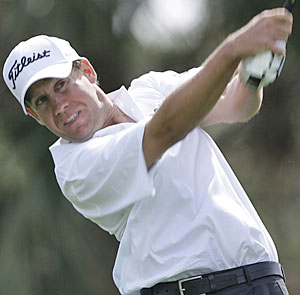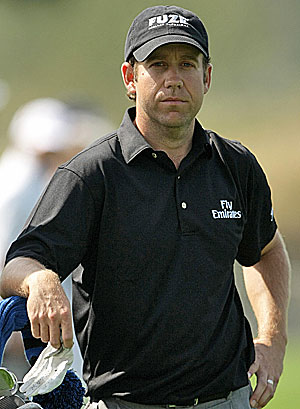When you come to think of it that is the secret of most of the great holes all over the world. They all have some kind of a twist. C.B. MACDONALD
Woods Expects No Ill Effects From 14-Day Layoff
/Bear Trap, Yang's Win Overshadowed By Rory's T-13th
/Oddsmakers Set NBC Final Round Over/Under On "Bear Trap" Mentions: 448
/Barney Frank: Order Up More Golf Sponsorship, Go Easy On The Excess
/Ron Sirak pulls an interesting clarification out of Congressman Barney Frank regarding the Northern Trust/TARP situation.
"No one is saying they shouldn't sponsor golf tournaments and honor existing contracts," Frank, the chairman of the U.S. House of Representatives Financial Services Committee, said in a telephone interview. "It's the spending on luxury hotels and limousines they should not be doing. Now, if they weren't getting federal money it would be up to them to decide if that's how they want to spend their money."
That's an improvement from Frank's original outburst in which he implied running a golf tournament was a waste of corporate money. But it still means the tour has some work to do in getting its message across to the power brokers in Washington.
"It's certainly good news that Congressman Frank understands the title sponsorship partnership component, but we also need to do a better job explaining the charitable aspects, the economic impact and the marketing benefits it creates for the companies involved," PGA Tour commissioner Tim Finchem said by telephone when told of Frank's clarified position. "We have to work harder to make sure the business model is being understood."
Suggestion Commish: start by not saying that you have to work harder to make sure the business model is understood. It'll go a long way toward gaining support from people who are tired of hearing jargon-laced corporatespeak as a substitute for straightforward talk.
"The plot at the Honda Classic, which already features its best field in years, just took a decided turn for the spectacular."
/ Mostly thanks to Erik Compton and a few other intriguing storylines. Certainly not the golf course.
Mostly thanks to Erik Compton and a few other intriguing storylines. Certainly not the golf course.
Amazingly Compton posted two 69s with a double and a triple on his scorecard.
"That's five months after his third heart was brought into an operating room packed in an ice chest, mind you."
/ Since I can only take one Nicklaus design a month, I was searching for an excuse to record the Honda Classic just so that I could relive PGA National in all its glory. Then Steve Elling reminded me how great a story Erik Compton is and how amazing it is that he's playing the Honda.
Since I can only take one Nicklaus design a month, I was searching for an excuse to record the Honda Classic just so that I could relive PGA National in all its glory. Then Steve Elling reminded me how great a story Erik Compton is and how amazing it is that he's playing the Honda.
Even we hardened, sarcastic, jaded beat writers were amazed the Compton story didn't gain more national traction last fall -- even after he was featured on the ABC evening news. Some of us slogged around Q-school watching him play, shaking our heads at how everybody had made a federal case about Tiger Woods' knee surgery -- he was out for eight months following a fairly routine procedure -- and how Compton was back five months after having his chest ripped open from stem to stern and then stapled back together.
That's five months after his third heart was brought into an operating room packed in an ice chest, mind you. It still gives me a lump in my throat.
Thanks to the help of a new agent -- former IMG player manager Peter Malik, the longtime representative for Mark O'Meara -- Compton has finally secured an endorsement deal, with Titleist. A book deal is being discussed, and it's sure to be one of the best golf tomes in years. You couldn't make up this kid's life story, really, since he received his first transplant at age 12.
“There's 18 of them.”
/Are Top Players Playing More?
/"Modern equipment has played a large part in this rush of young blood."
/While Ron Sirak attributes the emergence of teens Rory, Ryo and Danny to Tiger, John Huggan says their success at a young age may be thanks to equipment changes.
Such a phenomenon is relatively new in men's professional golf, certainly in terms of so many new and unshaven faces arriving at once. Where the women's game has long seen wee lassies in their mid-to-late teens capable of contending in the biggest events, it has traditionally taken longer for physically less mature laddies to achieve similar heights.
And...
So it is that, where the separation between good and great used to have much to do with the aesthetically pleasing art form that was shot-making, today the game is more about raw power. Very early – much earlier than before – young players armed with the requisite talent and nerve to survive with the very best begin playing basically the same muscle-bound game favoured by their supposed superiors. Accompanied by squeals of anger and disappointment from purists everywhere, draw, fade and feather have been replaced by crash, bang and wallop.
Which is not to say that there is not a lot of fun to be had from watching this new generation of stars in action.
True, but will the quality of play ultimately be impacted the way a rush of youth in the NBA has affected play, or is this just a natural progression of the sport?
"Arguments for a 36-hole final dry up pretty quickly -- especially when this option offers the potential of more compelling, star-studded action deeper into the week."
/John Maginnes weighs the pros and cons of the WGC match play's 36-hole final and can't find any good reasons to keep playing two rounds for the finale.
His piece appears on the Mothership's own website, so maybe this idea is gaining momentum? (Or, for conspiracy theorists, the decision has been made and the idea was merely started in Ponte Vedra and NBC...either way, Sunday semi's followed by an 18-hole final match would be a wise switch for everyone involved.)
"So you feel for Jack a little bit because you're not allowed to do it any more."
/I thought Geoff Ogilvy was kind (and insightful) on the subject of what appears to be another Jack Nicklaus design players don't care for. Geoff's typically original analysis:
Q. Tiger earlier in the week said these greens were quite severe. What's the difference between big curvaceous greens like these and big curvy greens like at Augusta National?
GEOFF OGILVY: The greens at Augusta look like they're supposed to -- they look like -- they look right. Most of them are built on the hill that they're on, their natural looking slopes, it doesn't look like people moved too much dirt to make those greens.
These ones look a little contrived. And they're a bit -- Augusta has the bigger sweeping kind of more natural looking hills. These ones have a few little steep things and such.
(Laughter.)
But it's probably almost genius greens. I mean, all the best golf courses in the world have really slopey greens. So you can see what he's trying to do. Greens are getting too flat probably because greens are getting too fast. You couldn't design Augusta right now, every player would walk off if we walked into Augusta the first time we had ever seen it, played a brand new golf course, we would all quit after nine holes. We would all say, "I can't play this, it's ridiculous."
So you feel for Jack a little bit because you're not allowed to do it any more. But they look -- I don't mind big slopes. I just don't -- they just don't look as natural as Oakmont or Saint Andrews or Augusta like the truly natural slopey ones.
So he's really saying that an architect can still pull off big, sloping greens if the contours are built properly.
Now, the three courses cited by Ogilvy all had one thing in common at the time of their creation: they were not constrained by USGA spec greens. Augusta has since gone to USGA greens and according to the people I trust who played them before and after, have lost a great deal of their character in the way of neat little bumps and rolls.
Not that this is a legitimate defense of poor green design, but it is something to keep in mind as the players pile on The Ritz Carlton Golf Club at Dove Mountain. (And if they were lukewarm while at the tournament, it only gets worse when they get off property! Playing PGA National this week won't help.)












